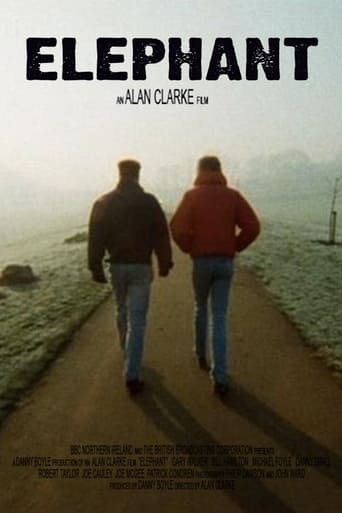Prismark10
The Troubles in Northern Ireland inspired a lot films and dramas. Some more controversial than others.Alan Clarke's Elephant was totally left field. When the BBC broadcast it, they were inundated with complaints on television programmes such as 'Points of View.'Never before we had a television drama, almost wordless where one person shoots another person, a few minutes later someone else shoots another and so on and so on. Be they working in a petrol station, in a swimming pool, playing football, eating in a restaurant, at home or walking in the park, someone blasts them.These horrific random acts of violence in due course desensitizes us, maybe even leave us bored and confused as without dialogue we are unsure as to what is happening and just seeing people walking about until they take a gun out and shoot somebody.Alan Clarke was an early adopter of the Steadicam for television work which means we follow the various people out and about as the camera operator is alongside them.This was one of Clarke's last works who died a year later. Seeing Elephant again many years later, when the film is almost 25 years old, you get struck that this is a period piece with the now old model cars and that Northern Ireland has moved on since the peace process.
keith_b
I was greatly amused at the writing credit for Bernard MacLaverty. Oh, you mean when that one guy said nothing or that other man didn't speak. Yeah, that's quotable stuff, all right. Certainly he wrote placement material used by the producer, although it is an absolute affront to say that he "wrote" anything.Still, it does give me a specific to use when pretentious people drool over lesser-known films. I can now praise MacLaverty's dialog and see what unfolds from there.The anonymity of the actions does reinforce the idea that violence can come at any turn and is never a proper solution. For that, I appreciated the film and its intent.
RobertF87
This film was made for British television in 1988, the last film by it's controversial creator Alan Clarke. There's no story here at all. Set in Northern Ireland, the film depicts a series of seemingly random killings.It is shot entirely on location with completely unknown actors. The film is quite disturbingly realistic. There is almost no dialogue in the film and absolutely no attempt to give the film any kind of context. The film is certainly well-made and impressive but the initial sense of shock fades before the film is over and the repeated images soon become dull, which might be the film's most disturbing aspect. In a way the use of gliding camera movements following characters either to their own deaths or to kill someone else, as well as the film's frequent use of holding on the image of the victims for some time after the killings take place can work against the involvement you might feel for this film. It is certainly worth watching, however. The casualness of the brutality and the haunting images linger for a long time after the end credits roll
Bart-53
In this picture not a word is spoken. Probably set in Northern-Ireland it consists of several unrelated scenes in which we follow, with the familiar 'HandyCam' shots of Alan Clarke one or two characters for several minutes until they approach a person ... and shoot him. I think it's the atmosphere, the long buildup before the actual kill, the complete lack of both emotion and conversation that made this movie work for me. Ten years after seeing this film I still remember several scenes. It gave me the feeling that I was watching the way the killings really happen(ed) in Ireland. I wish they would repeat it someday on television.
